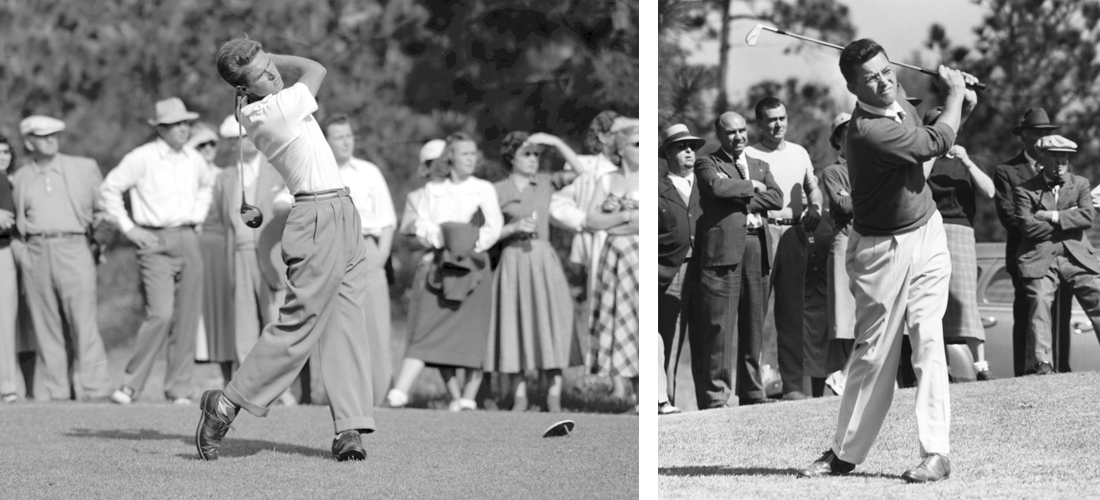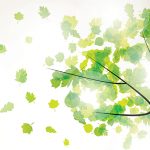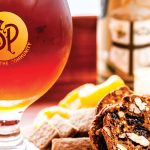
Double Trouble
The colorful legacies of Billy Joe Patton and Harvie Ward
By Lee Pace
One came from a small town in the western part of North Carolina, one from a small town in the east. One was a Wake Forest man when the Baptist institution was located in northern Wake County, the other a Tar Heel from the University of North Carolina. Both played golf with flair and color. They talked to the galleries and regaled the news media, their pictures appearing in national magazines (one of them smiling on the cover of Newsweek) throughout the 1950s. Both had outstanding short games and were deadly putters. They won five Carolinas Amateur Championships between them.
Each flirted with winning major professional championships in golf. Billy Joe Patton led the Masters on the final day in 1954 before twice hitting into Augusta National’s creeks and ponds and finishing third. Harvie Ward was tied for the lead in the 1957 Masters on the final day before hitting into the pond on 11, making double-bogey and fading as Doug Ford raced to the victory.
Patton led the U.S. Open after one round in 1954.
Ward won the U.S. Amateur in 1955 and ’56.
They played on eight Walker Cup teams (Patton five and Ward three).
They both won the North and South Amateur, Ward while a student at Carolina in 1948 and Patton in the height of his working-man/crack-golfer career in 1954, ’62 and ’63. Both were right-brained golfers where feel, touch and imagination were tantamount, and each thrived on Pinehurst No. 2, a venue requiring those skills in copious amounts.
“I loved playing No. 2. You had to play a lot of bounce-up shots,” Ward reflected years later. “You couldn’t play into the green. It was more like Scottish golf — you had to bounce it in there. You used to have to hit the chip-and-run or putt from off the green on those sand greens in Tarboro. There and playing at Pinehurst helped when I won the British Amateur. They were amazed over there how good I was hitting the pitch-and-run versus the flop wedge, where you hit it in the air and stop it by the hole. I adapted to golf over there very easily.”
“When I think of Pinehurst, I think of No. 2,” Patton said. “If I listed the five best golf courses I ever played, it would never leave my hand. I don’t know if I ever thought any course was any better. I think Donald Ross just took what he had. It was a desert of sand and scrub oak and pine, and the fellow just built a golf course on it. He didn’t build it around a lake because there wasn’t a lake there.”
And both at the height of their amateur careers rejected the idea of turning professional. There simply wasn’t the money to make it the same draw it is today. Ward sold cars and later became a club pro and expert golf instructor. Patton was in the lumber business.
“As it is now, I get a terrific kick out of playing golf,” Ward said in 1955. “It’s a pleasure, rather than work. I like it that way.”
“I’ve had a good life,” Patton said in 1994. “I’ve been happy. I’ve enjoyed my golf. I’ve enjoyed my friends. I’ve enjoyed my family. I’ve enjoyed my work. I’ve spent a lot of time doing the things I wanted to do. A man can’t ask for much more than that.”
Ward died in August 2004, succumbing to a long bout with cancer. Patton followed in 2011 at the age of 88 after several years living in a retirement home.
As huge as their respective shadows were across golf in the Carolinas, surprisingly they had very little face-to-face experience with one another.
“I was in college at Wake Forest,” Patton remembered in 2007. “It was 1940, I think. Harvie was a high school kid from Tarboro. They had this little tournament in Raleigh called the Eastern Carolina Amateur. He beat me 1-up. He couldn’t have been more than 15 years old and showed up in short pants. He’d never graduated to long pants. He was very straight off the tee and was a wonderful putter. That was aggravating, getting beat by a kid like that. There was a story in the paper after that match and my fraternity brothers gave me a lot of grief.
“I evened it up a few years later. We were playing in the Biltmore Forest Invitational. I was pumped up because he’d beaten me before. We played 16 holes and I had eight 3s on my card. In fact, from the eighth hole I made five 3s in a row. I closed him out on the 16th hole. Those are the only two times I remember us playing one another. I was older than he was and then later he moved off to California.”
Ward played a game that golf writer and historian Herbert Warren Wind once described as “archaically relaxed” and possessed a “rare gracefulness to his shotmaking that made him a treat to watch.”
“I never saw Bobby Jones play, but I saw everybody else, and Harvie was the best amateur I ever saw,” Ken Venturi said. “That’s the best amateur. Harvie didn’t have a pro bone in his body. He was too much a free spirit.”
Ward spent the last 15 years of his life living in Pinehurst, taught at Pine Needles and Forest Creek Golf Club, and mentored a network of young club and teaching professionals he had developed over the years. Ward told friends he “felt like a kid all over again” in the twilight of his life.
“Harvie never lived an unpleasant day in his life,” said Furman Bisher, the venerable columnist from the Atlanta Journal. “Or if he did, he didn’t show it. He was among the most untethered, unabashed people I’ve ever known.”
Patton’s style was established as a youngster in Morganton. He began swinging hard and never looked back. “I wanted to attack everything,” he said. “It was a war within myself, to hit that little ball as far as I could.” His knees were bent at address in exaggerated fashion. He had a strong grip, a whiplash waggle and a fast backswing. He cleared his left hip quickly through impact and cut his follow-through off at chest level, a move that later prompted Byron Nelson to call him a “slasher.”
Just as Ward was a maestro with the putter, so too was Patton.
“He never missed from 6 to 8 feet,” said Joe Cheves, the longtime pro at Patton’s home course, Mimosa Hills. “In all the rounds I played with him over the years, I never remember him missing from that range. He knew he was going to make it, and you knew he was going to make it. He was a very confident putter.”
Over the 1950s and through the ’60s, Patton enjoyed a remarkable run in national circles — not to mention in and around the Carolinas. His legend grew from one end of the Carolinas to the other.
“Billy Joe was a guy with professional ability playing in amateur tournaments,” says Hale Van Hoy, the Carolinas Golf Association executive director from 1965-1991. “Most tournament players of his caliber want to play their rounds all serious, without speaking to anyone, but he was always just as friendly, just as affable in the middle of a critical North and South round or U.S. Amateur round as he would be in a weekend game with the guys.”
The consummate Patton story came from the North and South Amateur one year in the late 1950s. Patton was on the second hole of a playoff with Dr. Bud Taylor and had hooked his tee shot onto the lip of a bunker bordering the long par-4. A hundred or so people watched as he addressed the ball awkwardly with a 4-wood, his right foot in the bunker, his left foot maybe 18 inches above it and the ball in the high grass. Meanwhile, a motorist who’d probably been trying to figure out Pinehurst’s curious maze of streets stopped her car on the road next to the gallery and asked, to no one in particular, “Does anyone know where I can get a room for the night?”
Patton continued waggling. “If you can wait a few minutes you can probably get mine,” he said.
The gallery erupted. Then Patton punched out, en route to a bogey. Taylor, safely in the fairway, parred the hole and won the match.
“It was more fun following Billy Joe in the woods than it was from the fairway,” longtime caddie Jerry Boggan said. “He was something else.”
Billy Joe and Harvie — both long gone, but both still generating chuckles and warm memories across the Carolinas golf landscape. PS
Golf writer Lee Pace has written frequently about Patton and Ward in a dozen books he’s written about golf in Pinehurst and across the Carolinas.30





